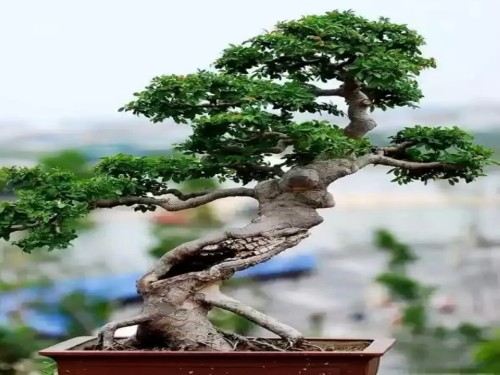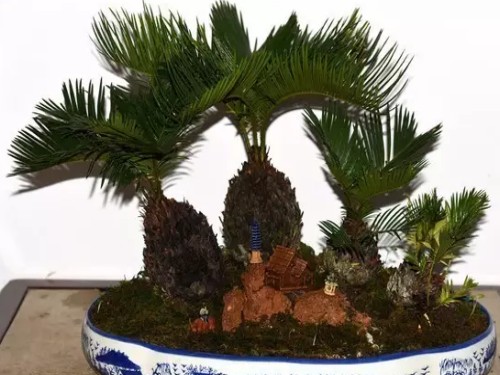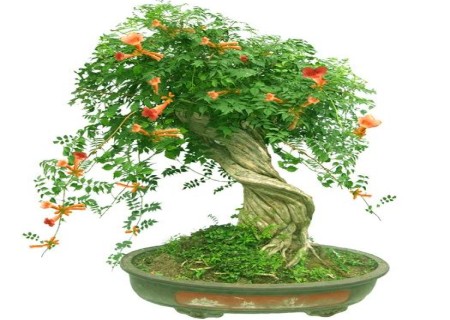Bonsai production technology of hammer elm stump
The trunk of hammer elm is straight, the crown is round and plump, the leaf is smaller than ordinary white elm, but it is very dense, and the effect of being a landscape tree and a street tree is very good. It is just that in the past, people did not know enough about it, only regarded it as bonsai material, and did not pay attention to its application in landscaping. At present, there is not much storage of elm, especially those that can be used as street trees, and the market potential is huge. I think practitioners with strength can develop appropriately. Compared with some other elm varieties, hammer elm is more delicate and more malleable, and he is optimistic about the development prospect of this tree species.
Nut elm is a suitable tree species in the subtropics, which is produced in the central and southern provinces of China. Hammer elm bonsai leaves are green, elegant and unrestrained, full of vitality, clear, dense, intertwined, hanging roots and claws and other styles are loved by the majority of bonsai lovers. Hammer elm itself is a very common tree species. After careful modeling by bonsai artists, it shows that the bonsai bonsai is vigorous and simple, Qiu Qiu qu, and the unique temperament of the old dragon bell. So how to make bonsai? the following editor introduces the production method of nut elm bonsai.

1. Pile selection
Pile selection should be strict, pile blank must be fresh, decaying, no root beard, as far as possible fine selection, do not pursue more, to ensure that the selected pile billet can survive.
2. Selection of basin
Hammer elm tree-shaped simple, strong vitality, it is appropriate to use purple sand pottery or glazed pottery pot planting, can also be planted with porcelain pot. The basin shape is determined according to the tree shape, the straight dry type uses the shallow round basin, the rectangular basin or the oval basin; the oblique dry type, the curved dry type, the horizontal dry type, the jungle type should use the rectangular or oval basin: the water type and the cliff type should use the square or round basin with a certain height, and the color should be simple and elegant.
3. Planting
Before sprouting in spring or in autumn, the roots, branches and leaves should be trimmed, the injured part of the cut should be smeared with white latex and sulfonamide ointment, and then some dry fine soil should be removed. When planting, apply appropriate amount of poultry manure or mud manure as base fertilizer and plant on slightly wet soil. Plant in the place where there is no direct sunlight (there should be enough scattered light). Do not water, but should spray clean water to the tree body 2 times three times a day, spray wet, and water once after 2 or 3 days. Keep the basin soil moist after half a month, and gradually move to the half-yin and half-yang place.
4. Modeling
The processing and modeling of hammer elm can be carried out by the combination of pruning and climbing, and brown wire or metal wire can be used for climbing. As the branches of hammer elm grow rapidly, they should be removed in time after climbing, so as not to sink the wire and affect its appearance. During the growth period, new branches can be cut off to promote branches and twist the branches. The elm has strong plasticity and can be processed into many forms. The common ones are straight dry type, oblique type, horizontal dry type, cliff type and stone-attached type and so on. Branches and leaves can be cut into pieces, or they can be trimmed into natural crowns. Another V is stone-attached hammer elm bonsai, the shape allows a certain degree of exaggeration, trees can be above the rocks, mainly trees, stone as the secondary, not subject to the "Zhangshan foot tree" restrictions.
In the modeling of hammer elm, the truncated storage technique is combined with pruning flat binding, the branches of hammer elm are relatively soft and can be tied with metal wire or brown wire; the branches and leaves can be cut into clouds or clouds, or they can be trimmed into natural crowns. Due to the rapid growth of nut elm branches, the climbing materials should be removed in time, so as not to cause "silk trapping" and affect the appearance. For the old stump excavated in the mountains, the over-thick trunk can be carved to reduce the volume, be commensurate with the side branches, and increase the ancient interest at the same time. The posture of the elm is usually carried out before the spring sprouting or in the rainy season.
5. Tree shape
Hammer elm has strong plasticity and is suitable for processing into many kinds of trees. The common ones are straight dry type, oblique dry type, horizontal dry type, cliff type, stone-attached type, co-planting type and so on. The branches and leaves can be tied into pieces or trimmed into a natural crown. In particular, the shaping of stone-attached elm bonsai can intercept a corner of nature and allow a certain amount of exaggeration. In order to render a certain part of the charm, trees can be above the rocks, mainly trees, followed by stone, without the restriction of "Zhangshan foot tree". Lingnan School, Su School and Yang School in bonsai in China often take nut elm as the main tree species.
The author believes that the reason why the elm is favored by people, relatively speaking: one is easy to draw materials, the second is rapid growth, the third is extensive management, the fourth is ornamental with or without leaves, and the fifth is not expensive. However, whether it can be made and maintained well, the author thinks that we should pay attention to solve the following six problems:
1. Solve the problem of "pulp running".
Finch plum is afraid of "shrinking branches" and hammer elm is afraid of "running pulp". Therefore, most colleagues who cultivate hammer elm will carefully deal with the problems of digging, sawing, chiseling wounds and cross-section "running in the face of water". The solution to "slurry running" is generally air-drying, plant ash, mud, latex, hot beeswax, erythromycin ointment, etc., and pay attention to do not immediately pour "root water" when planting, wait 2-3 days before watering. As long as we can put an end to "pulp running" and pose no threat to the survival of the elm, we can get twice the result with half the effort.
2. Solve the problem of "the branches are not in place"
"the taste of the elm is excellent, and the poor branches hinder the viewing." Although this problem is not fatal, it spoils the scenery, affects the viewing, and is not perfect. For this reason, the author has also imitated the position selection "hammering method" many times, but it is difficult to work, so I have to pull the nearby branches and take bends to make up for the missing parts. In fact, the lack of branches is not only a problem of nut elm bonsai, but also a common problem of all tree stumps.
3. Solve the problem of "undressing and changing brocade"
The best viewing period for elm bonsai should be lost. For this reason, the author has pruned the elm again several times about 2 months before the exhibition or festivities, removed all the leaves and urged it to show the best viewing period again. There are three ways to remove leaves: first, cut off leaves with flower scissors; second, put the plant in a corner of the hall, causing leaves to fall off naturally; third, "buckle water" for 5 to 7 days, resulting in short-term interruption of water supply and forcing leaves to fall off. The first method is time-consuming, labor-consuming and energy-consuming, but it is safe and reliable. the second and third methods are forced to shed leaves on their own, but they must master the "heat" well, otherwise it will affect the normal growth of the plant.
4. Solve the problem of water and fertilizer management.
Watering should be dry and wet, dry and thoroughly. Too much watering, the root is too wet, affecting the root respiration, resulting in the death of rotten roots. Too little watering, the basin soil dried up, the plant growth stagnant. If the water is cut off for a long time, the plant will dry up. Spray less water to the leaves to prevent the leaves from being too large and the new branches grow too long, affecting the ornamental. In the heat of summer, sprinkle water on the ground to increase the humidity of the air.
To facilitate plant growth. Usually watering should be "six look": look at the soil watering, do not water, water thoroughly; look at the tree watering, the tree is mostly watered, the tree is small and less; look at the basin watering, the basin is small and much, the basin is large (deep) less; look at the weather watering, the weather is sunny and much, the sky is cloudy and less, the rain is not watered; look at the plant growth condition, the growth is more watered, the growth is weak and less; look at the position of the bonsai, watering more in the sunny place and less in the shady place. In short, watering avoid stereotyped, avoid "too often".
Nut elm avoid big fertilizer, usually to master the frequent application of thin fertilizer, avoid the application of "thick fertilizer", avoid the application of unrotten organic fertilizer. The growing period of Ulmus pumila is from April to October every year, you can choose sunny (cloudy) evening, apply thin cake fertilizer or "compound fertilizer" liquid once or twice a month (no fertilization in plum rain season and hot summer days). It is best to apply one more phosphate fertilizer-bone meal before the Beginning of Winter to enhance the cold resistance of the plant. Fertilization should be mastered: old tree pile less fertilizer, strong pile more fertilizer; shaped pile less fertilizer, culture pile more fertilizer; growing vigorous pile more fertilizer, growing weak pile less fertilizer. No fertilizer is applied during dormancy. In short, avoid applying "thick fertilizer" to prevent "fertilizer harm".
5. Solve the problem of basin soil and basin turning.
Nut elm is resistant to hemorrhoids and is not strict with soil. Self-made basin soil, generally can take ordinary soil (mountain mud or pond mud), freshwater sand (coarse sand) 40% each, coal slag (sterilization breathable) or saw wood chaff (loose) 20%, plus some dry poultry manure or compound fertilizer, mixed to form culture soil. In the use time, the soil can be sprayed and stirred (kneading can form a ball, falling to the ground can be dispersed), fill the root of elm and compaction, wait for 2-3 days and then pour "fixed root water", so as not to endanger the survival of the root wound.
Ulmus pumila has strong vitality and fast growth, so the basin should be turned every 2 years or so, and the best time is before spring sprouting. When turning the basin, it is necessary to cut off the rotten root, withered root and part of the old root and long root, remove the 1ther, 3pm and 2ratoon soil, and fill it with fertile, loose and well-drained new culture soil.
6. Solve the problem of prevention and control of diseases and insect pests
The common pests of hammer elm bonsai are aphids, red spiders, elm clams, etc., which can be sprayed with 2000 times of 30% Shongwang EC, and the effect is very good. The larvae of "longicorn beetles" (longicorn beetles) lurk in the wormhole, first stab it with wire into the hole, then soak it with cotton balls and plug the hole with malathion, and coat it with yellow mud. The formed longicorn beetles can be hunted and killed manually. If root rot is found (showing that the leaves fall off and the branches die), turn the basin and change the soil in time, cut off the corrupted roots and branches, apply 1000 times liquid carbendazim, and then put on the basin after the liquid is dry.
Time: 2019-05-26 Click:
- Prev

The method of making Iron Tree Bonsai
The iron tree, whose real name is Cycas, is a small evergreen tree of the genus Cycas of the Cycads family, and is a precious ancient relict plant. Cycads native to the mountains of Fujian are mainly cultivated in China. In recent years, Sichuan Panzhihua cycad, Yunnan cycad and so on, have also been introduced and cultivated in various places. Cycads are graceful in shape
- Next

Bonsai technology sharing: how to make Lingxiao bonsai
Lingxiao was recorded in the Book of songs as early as the Spring and Autumn period. At that time, people called Lingxiao Lingxiao, which is called Lingxiao. The name of Lingxiao flower began to appear in Tang Materia Medica, which is said under Ziwei: this is Lingxiao flower, and stems and leaves are used. The beauty of Lingxiahua impressed many flower friends.
Related
- Fuxing push coffee new agricultural production and marketing class: lack of small-scale processing plants
- Jujube rice field leisure farm deep ploughing Yilan for five years to create a space for organic food and play
- Nongyu Farm-A trial of organic papaya for brave women with advanced technology
- Four points for attention in the prevention and control of diseases and insect pests of edible fungi
- How to add nutrient solution to Edible Fungi
- Is there any good way to control edible fungus mites?
- Open Inoculation Technology of Edible Fungi
- Is there any clever way to use fertilizer for edible fungus in winter?
- What agents are used to kill the pathogens of edible fungi in the mushroom shed?
- Rapid drying of Edible Fungi

